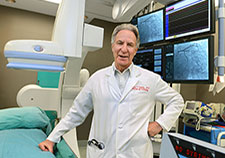Office of Research & Development |
 |
Office of Research & Development |
 |

VA Research Currents archive
June 9, 2014

Dr. Barry Uretsky is an interventional cardiologist with the Central Arkansas Veterans Health System. (Photo by Jeff Bowen)
In a time when most doctors would be happy to reduce their workload, Dr. Barry Uretsky has some advice for his fellow interventional cardiologists: Keep the pressure up.
Air pressure, that is. Cardiologists use high-pressure inflation to place coronary stents—small wire mesh tubes that get threaded into narrowed arteries to prop them open and restore blood flow to the heart.
The stent is crimped around a limp balloon at the tip of a catheter. Doctors guide the stent toward the plaque build-up in an artery and then apply air to the balloon. As the balloon inflates and stretches the plaque, it also expands the stent until it is pressed snuggly against the lining of the blood vessel. Then the balloon is deflated and backed out, and the stent remains in place to scaffold the blood vessel.
How long should high pressure be applied to expand the stent? That question is not exactly a hot issue in the pages of cardiology journals. But Uretsky's research, published in March 2014 in Catheterization and Cardiovascular Interventions and presented at some recent conferences, suggests maybe it should be.
Uretsky says the duration of the pressure can mean the difference between a stent that is properly placed and one that is not. A poorly placed stent can heighten the risk of complications down the road, such as blood clots around the stent, or a re-narrowing of the artery.
His technique? Prolonged pressure—about 200 seconds, on average. That's about seven times longer than the current practice. He says that's what it really takes to thoroughly expand the stent.
"We think that the way stents are being implanted now by 99.9 percent of physicians all over the world is incorrect, and we think that the approach we've recommended is the correct technique," says Uretsky, with the Central Arkansas Veterans Healthcare System and the University of Arkansas for Medical Sciences. "The reason is that it fully expands the stent, and it improves strut apposition."
Struts are the super-thin individual strands that make up the mesh stent, and they are said to be "malapposed" when they are not neatly pressed up against the artery wall. Over time, if all goes well, tissue grows over the stent and it becomes almost like a natural part of the artery lining.
Notwithstanding his bold proposition about the fundamental flaw in how most cardiologists are handling the procedure, Uretsky points out that "this aspect of stenting has not received a lot of attention or interest in the medical community."
He says once other cardiologists hear his explanations and see his findings, they seldom disagree.
Part of Uretsky's evidence comes from a newer imaging method called optical coherence tomography (OCT). It uses light to create extremely high-resolution images of the inside of blood vessels. Heart doctors can examine a vessel as they do a procedure, and it's almost like they're examining the tissue under a microscope. Among other things, they can zoom in on the hundreds of individual struts in a stent and see how many are "malapposed."
"OCT has enabled us to observe this problem more easily," says Uretsky. "We already known about it from intravascular ultrasound, but OCT has much finer resolution."
In a recent study that involved 12 heart patients undergoing stenting, Uretsky's team first placed the devices using the conventional method. They then did an angiography—the standard way cardiologists check to make sure a vessel is no longer blocked. They followed that with an OCT scan. Then they re-inflated the balloon until the same pressure that had been used previously was maintained for at least 30 seconds, without any drop in pressure. That's the sign, according to Uretsky, that the stent is no longer expanding. Anything short of that, he says, and the job is not complete. The stent is not fully pressed against the vessel wall as it should be.
The team completed the study protocol with a second OCT scan, so they could compare stent apposition before and after the prolonged pressure. The OCT pictures tell the story, with a clear advantage on the side of prolonged pressure.
"No one has questioned the data we provided in our article, but they do ask how it relates to outcomes," says Uretsky. In other words, do small differences in the quality of stent placement really translate into better patient outcomes?
Uretsky says only a large clinical trial—say, with 10,000 patients or so—could answer that question definitively. He is not sure if such a trial will be organized anytime soon, but meanwhile he is preaching the gospel of prolonged pressure to whoever of his colleagues will listen. So far, his journal article on the topic has generated more than a few enthusiastic responses.
"From time to time physicians will write to me saying that after reading my article, they've actually modified their practice to maintain balloon inflation pressure longer during stenting," says Uretsky. "I know anecdotally that people are picking it up."
He recalls one email in particular, in which the doctor wrote, "I've been doing this technique [prolonged inflation] for years, and my partners say I'm crazy. So I'm glad to see your study—it validates what I know intuitively is true."